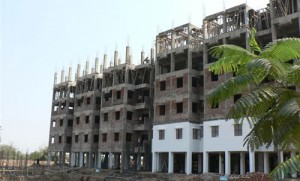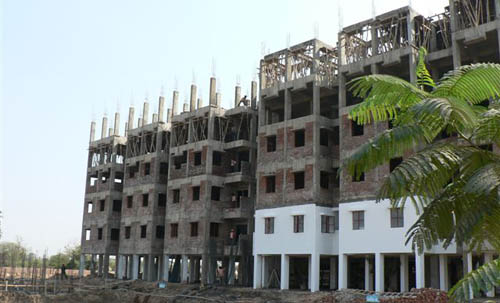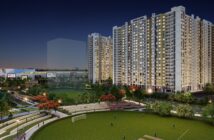 Track2Realty: The total new demand that could be generated for residential dwellings in the period 2012 – 16 will be 11.8 million units across India, says a new report by Cushman & Wakefield. Of the total additional demand, the top 8 cities will be constituting 18% or 2.1 million units across categories. The annual report “Evolving Paradigm – Future Of Indian Real Estate” is in association with Global Real Estate Institute (GRI).
Track2Realty: The total new demand that could be generated for residential dwellings in the period 2012 – 16 will be 11.8 million units across India, says a new report by Cushman & Wakefield. Of the total additional demand, the top 8 cities will be constituting 18% or 2.1 million units across categories. The annual report “Evolving Paradigm – Future Of Indian Real Estate” is in association with Global Real Estate Institute (GRI).
The additional or new demand that can be generated in 2012-2016 is calculated based on the past trends for population and household growth and the income classification for the households. Hence, this does not take into consideration, existing unfulfilled demand by those without homes, living in congested homes and or in dilapidated structures. the Ministry of Housing & Urban Poverty Alleviation estimates such demand resulting from housing shortages at 18.78 million units for the entire country. C&W’s estimates also do not consider the existing or future demand from those living in rental houses and wanting to shift into their own houses, demand from NRIs or those wishing to purchase second homes/holiday homes for personal use and/or investments.
Of the total additional demand in the top eight cities, demand for mid-segment is estimated to be highest at approximately 59% or 1.3 million units, followed by demand in the high-end segment which is 451,000 units. The low-end segment is expected to see 362,000 of fresh demand in these cities in the next five years.
Sanjay Dutt, Executive Managing Director, India said, “The demand creation in leading 8 cities is a reflective of the economic strength that these cities have, that attracts new settlers as well as creates conducive environment for natural population growth. We see a higher demand in the mid-ranged segment in these cities that further explains that there is a rapid growth in the economically viable population in these cities which is helping them and the cities in creation of wealth.”
| City | Total Estimated Supply (MIG+LIG) in `000 | Total Additional Demand (MIG+LIG) in `000 | % Share of MIG Homes in Total Gap in each City |
| Ahmedabad | 51 | 173 | 78% |
| Bengaluru | 192 | 339 | 55% |
| Chennai | 159 | 258 | 90% |
| Hyderabad | 89 | 200 | 57% |
| Kolkata | 84 | 77 | 0% |
| Mumbai | 141 | 189 | 100% |
| NCR* | 336* | 381 | 27% |
| Pune | 112 | 144 | 53% |
| TOTAL | 1.16 million units | 1.76 million units | 70% |
* Staggered supply as delays in construction expected based on past trends
The total demand for housing units is expected to increase at a Compounded Annual Growth Rate (CAGR) of 2.8% across India, with Bengaluru expected to the record the highest CAGR in demand of 4.1% followed by Pune and Hyderabad. NCR is expected to see the highest demand of 381,000 units in mid and high-end segments during 2012 – 2016. The three southern cities namely Bengaluru (338,546 units), Chennai (257,796 units) and Hyderabad (199,575 units) account for approximately 45% of the demand in mid and high-end segments. In the western region, Mumbai is expected to see demand of 188,708 for mid and high-end housing while demand in Ahmedabad for the same category will be an impressive 173,394 units. Pune is estimated to recorded demand of approximately 144,422 units while Kolkata’s mid and high-end demand is touted to be only about 77,000 units.
Sanjay continues, “The residential housing demand can be seen as an indication of the current and future economic activities in these cities. Majority of the growth in demand (in the top 8 cities) is expected to come from the services sector, in cities of Bengaluru, Hyderabad, Mumbai and NCR, Pune and Chennai will see demand on account of both services as well as manufacturing sectors. Ahmedabad’s demand, in addition to migrant population, is driven by indigenous growth in population and also many re-settlers who intend to return to the city after having spent a fair deal of time in other locations across the globe.”
The supply for mid & high-end residential units is expected to be 1.16 million units during 2012 – 16 in the eight major cities. With the expected demand as stated above, the short fall of new housing units is expected to be approximately 600,000 units across the top cities in India. The total supply for 2012-16 is based on projects that are currently under construction or plans for which have been announced for by developers in each of the top eight cities.
The highest supply in mid and high-end categories will be NCR (334,000) followed by Bengaluru (191,708 units) and Chennai (159,056 units). Supply of mid-ranged properties, which is estimated at nearly 900,000 units in the next five years, is expected to be nearly four times that of high-end residential units, expecting to see a total supply of 260,000 units, across the major 8 cities.
Bengaluru is expected to witness the highest demand-supply gap for both MIG and HIG housing, followed by Ahmedabad and Hyderabad. As a result, property prices in these cities are likely to appreciate during the five year time period. However, moderation of supply by holding back new project launches and unforeseen project delays by developers may reduce the gap between demand and supply in the next few years.
NCR
NCR is expected to witness the highest demand across mid and high-end segments at 381,000 units during 2012 – 2016. With a 70% share of the additional demand in the next 5 years, the MIG category in the NCR currently has a comparable supply pipeline to meet this additional demand. There is also a sizeable supply of mid-segment units in various stages of construction in NOIDA, NOIDA extension and Greater NOIDA. Nearly 70% of the mid-segment units are expected in these micro markets by 2016.
A plethora of economic activities such as the services sector including IT/ITeS and BFSI, the SMEs in the peripheral locations, the public sector undertaking and government administrative units, feed into the demand for mid-segment housing and given the city’s economic and political importance, this demand is expected to remain strong. With improvements in civic administration, public transportation and road networks, the city’s attractiveness quotient has improved attracting more settlers every year.
The demand for high-end housing is expected to be 114,360. However, the current under construction and planned supply for meeting the additional HIG demand is expected to be short by around 30%. Gurgaon is emerging as a hotspot for luxury residential housing with some projects selling at around Rs. 30,000 per sf, whilst most other high-end projects are selling at around Rs. 14,000 sf on an average. In Greater Noida, though the current rate for high-end apartment projects is around 6,000-8,000 per sf., luxury villa projects are currently quoting at Rs. 23,000-26,000 per sf.
Mumbai
Mumbai is expected to witness additional demand of 189,000 units for mid and high-end segment in the next 5 years while the supply in these categories will be 140,806 units. Of the total demand in these two segments, majority (70%) will be seen in the mid-priced housing, but will remain underserviced by 50% in the next five years. Majority of the mid-segment supply is also expected to be in the Greater Mumbai regions of Thane District & Raigad District due to affordability issues within the city. However, given the current high costs of land, raw materials and other input costs, the per square foot rate for mid-range apartments is not really expected to come down. The scarcity of land is leading to the construction of more high-rises even in the suburbs, which push up the costs and prices further. As a result, developers are decreasing the sizes of the units to keep the overall ticket price low and affordable.
The demand in Mumbai’s residential market is created mostly by migrant population, a phenomenon that lasted for close to a century. However in recent times, it is noticed that largest population influx has been in cities with predominance in manufacturing, and services such as IT/ ITeS, banking, insurance, financial services, and engineering, amongst others as they support a large manpower base. This highlights less dependence on any one sector in sharp contrast to other markets. The existing high real estate costs further dissuade many migrants and even companies from shifting to the city.
Based on regular estimates, the high-end segment, which expects a demand of 56,000 units, will be over supplied by 33%. However, the maximum future supply is estimated to be within the Rs.1 crore to Rs. 3 crores price bracket with a 63% share in the total current supply in the pipeline. Given that the city has the highest per capita GDP in the country, as per Mumbai’s standards, this supply would be deemed to fall within the upper end of the MIG segment. Thus, it is expected that there is still sizeable demand in the above Rs. 3 crores price bracket. This is borne out by the number of high-rise towers that have been launched and are currently in construction within the city. These high-rise towers offer luxurious spaces and finishes, ultra-modern facilities and amenities, superior construction and designs and are resplendent with lifestyle offerings that are comparable to the best in other international cities. In 2011, more than 3,500 luxury units were launched and around 1/3 of last year’s numbers have been launched in this year so far mostly in areas like Worli, Wadala, Goregaon and Dadar.
Kolkata
Kolkata is the only city in the top eight, which is expected to buck the demand-supply trend for the future. Kolkata is expected to see a demand of approximately 77,000 units for the mid and high-end segment over the next 5 years, of which 80% will be for mid-level housing. It is also the only city in the study which could have the expected supply surpassing the demand for mid segment housing in this period. The supply in the high-end segment is expected to remain lower than demand for the segment.
With very staggered and incidental growth in services sector in the city, Kolkata is not witnessing an incremental influx of migrant population like others, which is the primary reason for lower demand while the expectation from the developers was much higher – visibile from the pipeline of projects. Developers in Kolkata would therefore, need to carefully evaluate their options and ensure that their projects are priced and targeted at the right customers as the current supply pipeline seems to be on track for mid and high-end segments. Alternative neighbouring markets such as Bhubaneshwar, Guwahati etc would continue to attract investments from Kolkata developers and investors.
Ahmedabad
Ahmedabad will see a total fresh demand of 173,394 units in the next five years, of which nearly 80% will be in the mid-ranged category. The high-end will make up for the rest 20%. There is a growth in demand from both current inhabitants of the city and from the migrant population, which is attracted to the established economic base in the city on account of growth in industrial and manufacturing sector in the periphery of Ahmedabad.
A significant part of the demand, especially in the high-end segment is being created by migrants largely from other parts of the state, though their’s is substantial migration from other states too. These migrants are being attracted by the increasing commercial and industrial activities in the State that are witnessing substantial investments, largely due to the State Government’s investor friendly policies and emphasis on infrastructure creation. There will however, be a gap of 31% in supply to the total demand in the mid-ranged segment while the high-end segment is expected to see a gap of 22%. The current under construction and planned supply is expected to be mostly geared towards high-end demand.
Pune
With the growth of the services and the manufacturing and industrial sector, Pune has been witnessing an unprecedented growth in population as well as economic activities. This is giving rise to demand for housing in the city, which is expected to be approximately 144,000 units in the mid and high-end segments. Of the total additional demand, 75% will be in the mid-segment group totalling to 101,096 units. This is on account of the large influx of workforce in the services category in industries such as IT/ITeS, other services, manufacturing, auto and auto ancillary, heavy engineering, etc. However, the currently planned supply will not be able to cater to the entire additional demand for mid-end and will be short by 27%.
Pune is also one of the leading Tier II cities, which has demonstrated rise in lifestyle appealing, branded residential developments. The size, specifications and price of residential units is significantly higher than the average of neighbouring micro markets. Recent interest from the rich and famous of Mumbai wanting superior upmarket, branded apartments, which they find attractive when compared to the prices of upmarket locations in Mumbai and their finishes.
In the same time frame of 2012 – 16, the new demand for high-end properties is expected to be 43,327, which will remain under – serviced by almost 35%, going by the currently expected supply in this category.
Bengaluru
Bengaluru is expected to be the most active residential market in the next five years (2012 – 16). The demand for residential units in the mid and high-end categories is expected to be 191,708 units in the next five years. Of the total demand in the two categories, new mid-ranged demand would be approximately 75% with only 68% of the necessary supply currently in the pipeline under various phases of planning and construction.
Similarly, the city is expected to witness only 23% of the current under construction and planned supply for meeting the additional HIG demand which is estimated to be approximately 84,000 units in the next 5 years. Currently, the HIG demand is being catered to mainly through the launch of luxurious villa projects in north and east Bengaluru. New concepts in the form of designer homes, twinaments/doublements and villaments are also being offered in the high-end and luxury segments.
Chennai
Chennai’s residential demand is expected to be one of the strongest in the southern part of India. Demand is expected to be stronger than some of the traditionally high demand markets such as Mumbai and Pune. Chennai’s steady growth as an IT/ITeS and industrial and manufacturing hub in the southern part of the country is expected to create new demand of around 257,000 units in the mid-ranged and high-end categories in the next 5 years (2102 – 16). Chennai’s traditional importance as a port city and educational centre of the south remains unchanged. However, the increase in industrial activities is driving the demand for housing, which is mainly in the mid-priced range and mainly in areas close to the industrial corridors. Of the total demand in both segments, 90% (232,000 units) of the additional demand in the next 5 years is expected to be in the MIG category.
Expected supply on the other hand, will fall short of the total new demand in the mid and high-end segments. In both the segments, the current expected supply will fall short by nearly 38%
Hyderabad
In the next five years (2012 – 16), Hyderabad is expected to see an additional demand 199,575 units of residential property in the mid and high-end categories. Of this total demand, mid-ranged is expected to be approximately 65%. Steady growth in the services sector, mostly driven by IT/ITeS has been responsible for the influx of people from across the country to the city. Hyderabad’s unique advantage of local language and local food habits makes it a popular destination for migrant population. Even with some political unrests flaring from time to time, the city has remained attractive for migrant population.
The uniqueness of Hyderabad’s demand was in the fact that of the total demand (mid & high-end) a sizable demand of 35% was in the high-end category. This can be attributed to the fact that the city has relatively large percentage share of High Networth Individuals that has been keeping demand for this section buoyant.
The expected supply in the categories will fall short of the total demand for mid and high-end residential demand. While the mid-ranged will remained under serviced by almost 50%, the supply in the high-end segment will be short by approximately 70%. A part of this gap in supply to demand can be attributed to the recent development regulations that were ambiguous, leading to many developers holding on to their future development project until further clarification. Going forward this gap may be reduced as there has been some clarity on the government policies.





